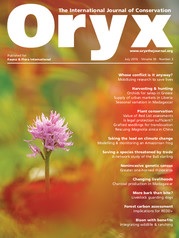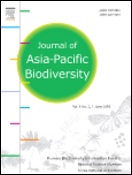|
Alumni Publications
 de Lima, R.F., E. Maloney, W.B. Simison & B. Drewes. (2016) Reassessing the conservation status of Crocidura thomensis, endemic to São Tomé Island. Oryx 50 (2): 360-363. doi: http://dx.doi.org/10.1017/S003060531400091X de Lima, R.F., E. Maloney, W.B. Simison & B. Drewes. (2016) Reassessing the conservation status of Crocidura thomensis, endemic to São Tomé Island. Oryx 50 (2): 360-363. doi: http://dx.doi.org/10.1017/S003060531400091X
The shrew Crocidura thomensis is a little-known species endemic to São Tomé Island. We review its distribution, ecology and conservation status based on nine published and 23 new records. The species has a wide distribution across São Tomé, preferring rugged forested areas with high rainfall. The location of new records coincides with that of historical records but the proportion of records in plantations has declined, possibly as a result of agricultural intensification, increased use of pesticides, and presence of exotic species. The shrew is restricted to a single island, its extent of occurrence is < 1,000 km2 and its habitat is declining in extent and quality, and thus its categorisation as Endangered on the IUCN Red List remains appropriate. It is important to gain a better knowledge of population trends, ecological preferences and sensitivity to potential threats, but the effective protection of São Tomé Obô Natural Park and surrounding forests is the most important measure to ensure the long-term survival of this mammal.
 Kanagavel, A., Parvathy, S., Nameer, P. O., & Raghavan, R. (2016) Conservation implications of wildlife utilisation by indigenous communities in the Southern Western Ghats of India. Journal of Asia-Pacific Biodiversity doi:10.1016/j.japb.2016.04.003. Kanagavel, A., Parvathy, S., Nameer, P. O., & Raghavan, R. (2016) Conservation implications of wildlife utilisation by indigenous communities in the Southern Western Ghats of India. Journal of Asia-Pacific Biodiversity doi:10.1016/j.japb.2016.04.003.
Wildlife utilisation in the tropics is massive, with nearly five million tons of bushmeat consumed by local communities. In India, a megadiversity nation, hunting—although illegal—is widespread among indigenous communities. However, the extent, frequency and rationale for hunting, and factors influencing wildlife utilisation are poorly known. Our study, based on 19 different indigenous communities in the Western Ghats region, revealed the utilisation of 54 wild species/taxa. Although freshwater fish, herpetofauna and small mammals were most frequently utilised, enforcement by the Forest Department was largely focused on large mammals. Gender, land ownership, number of domestic meats consumed, distance to markets, time spent hunting, and distance to hunting areas were major factors that affected wild meat utilisation in the region. Although conservation needs to be focused on the most utilised groups, increasing access to domestic meats at remote settlements and integrating utilisation of common, culturally prominent species can improve conservation of threatened fauna.
 Schneider, L., Ferrara, C.R., Vogt, R.C., Schaffer, C. (2016) Subsistence-Level Chelonian Exploitation on the Rio Negro and One Viable Alternative. Chelonian Conservation and Biology 15(1):36-42. Schneider, L., Ferrara, C.R., Vogt, R.C., Schaffer, C. (2016) Subsistence-Level Chelonian Exploitation on the Rio Negro and One Viable Alternative. Chelonian Conservation and Biology 15(1):36-42.
In the Rio Negro, the third-largest tributary of the Amazon, many turtle species have been important commercial and protein resources for centuries for populations of humans living in the region. For many years, this had been a sustainable activity, but nowadays the outlook for turtle populations in the Amazon is unfavourable due to increasing hunting pressure. Based on 20 years of conservation work in the Amazon, we report on the pressure faced by turtle populations in the area and report a sustainable chelonian exploitation alternative developed in the Rio Negro region. We describe the materials and the hand processing that artisans use to transform natural resources into artworks. Based on this community programme model, we discuss the current government support to local communities of the Rio Negro and provide insights on the application of this economic alternative to substitute for turtle commercialisation in the Amazon. The outcomes of this manuscript have direct applications for environmental managers, nongovernmental organisations and policymakers in Brazil, and aim to call government and environmental managers to promote turtle conservation in the Amazon, securing economic safety for local communities.
See all alumni publications
|